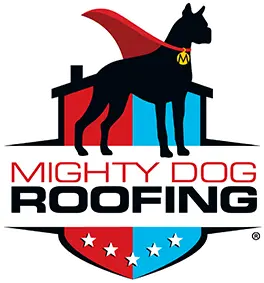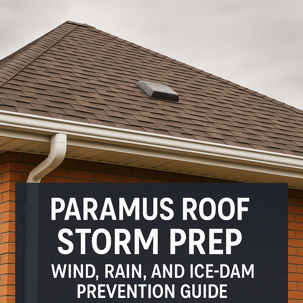Paramus Roof Storm Prep: Wind, Rain & Ice-Dam Prevention Guide
Storms in Paramus can bring heavy rain, high wind, and freezing temperatures — the perfect mix for roof damage. Each season adds stress: rainwater testing your gutters, snow adding weight to your roof deck, and wind threatening to lift asphalt shingles at the roof edge.
This local homeowner guide explains how to inspect, reinforce, and protect your roof before severe weather hits. You’ll learn how to manage water flow, improve attic insulation, secure weak points, and document your home for insurance coverage.
Step 1: Inspect Roof Edges and Shingles
Start with a ground-level inspection. Use binoculars or a zoomed camera to look for:
Curled or cracked shingles: These allow water under shingles, breaking the water seal.
Loose or missing tabs: These areas can catch wind-driven rain and cause leaks.
Granules in gutters: This signals aging asphalt shingles and surface wear.
Pay special attention to the roof edge, where uplift from high wind is strongest. If you see loose metal flashing or lifted shingles, schedule a roof repair before the next storm.
Step 2: Clear and Test Your Water Management System
Your gutters and downspouts form the first defense against water damage. Clogged gutters force water to overflow, stain fascia boards, and soak the roof deck.
Remove debris and flush with a hose to check flow. Make sure water travels freely and exits at least four feet away from your foundation. If downspouts splash near your home, add extensions. Consistent water flow reduces hydrostatic pressure on your foundation and prevents long-term mold growth.
Step 3: Check Attic Insulation and Ventilation
Attic insulation keeps heat inside your home while proper ventilation allows trapped moisture to escape. Without balance, warm air melts rooftop snow that refreezes at the eaves — forming ice dams.
Inspect insulation for damp spots, dark patches, or mold growth. Wet insulation reduces thermal efficiency and signals water intrusion. Ensure soffit and ridge vents are clear to help air circulate evenly through your attic space, maintaining stable roof temperatures all winter.
Step 4: Secure Trim, Flashing, and Rooftop Equipment
Loose trim boards, soffits, and flashing are common weak points that allow rain intrusion. Check each connection along the fascia and resecure with corrosion-resistant fasteners.
Inspect flashing around chimneys, skylights, and vents for cracks or rust. Apply roofing cement to reseal small gaps. Secure satellite dishes, solar mounts, and HVAC units firmly to resist high wind. Even a small gap lets wind-driven rain penetrate and degrade roofing materials over time.
Step 5: Manage Trees and Exterior Hazards
Overhanging tree limbs act like wind sails during storms. Trim back branches that hang over your roof or brush against siding. Falling limbs can damage shingles, dent flashing, or tear gutters from the roof edge.
After trimming, remove yard debris and secure outdoor furniture. Loose items can become projectiles in high wind, striking roofing shingles or windows.
Step 6: Document Your Roof’s Condition
Before every major storm season, take date-stamped photos of your roof, gutters, fascia, and attic interior. These images serve as proof of maintenance if you ever file a claim with your insurance company.
Document:
Each roof slope and ridge line
Flashing at chimneys, skylights, and vents
The condition of your attic insulation and ceiling surfaces
Keep digital copies backed up. Proper documentation prevents disputes over “pre-existing” damage after a major weather event.
Step 7: Emergency Tarping and Temporary Repairs
If a storm compromises your roof, quick action limits water intrusion. Cover damaged sections immediately with a waterproof tarp that extends at least three feet past visible damage. Cross the tarp over the roof ridge for complete coverage and secure it with 2×4 wooden battens screwed into the structure.
A tight seal prevents water under shingles and protects your interior until permanent repairs are made. Keep all receipts for materials and labor — insurers usually reimburse temporary mitigation costs.
Long-Term Roof Maintenance for Paramus Homes
A roof in Paramus endures constant environmental stress — from high water pressure during downpours to the freeze-thaw cycle that cracks seals. Preventive maintenance is the best way to extend its lifespan.
Clean gutters twice yearly to keep your water system flowing.
Inspect shingles and flashing each spring and fall.
Replace aged asphalt shingles before adhesion fails.
Repaint fascia boards to protect against water stains.
Use metal roofing or Class F/H shingles for higher wind resistance.
Maintain insulation and ventilation to avoid condensation and ice dams.
Simple steps like these reduce roof leaks, preserve your water seal, and protect your home from long-term damage.
When to Call a Professional
If your inspection reveals missing shingles, visible water stains, or soft spots on the roof deck, contact a licensed local roofer.
Mighty Dog Roofing of Northeast New Jersey serves homeowners across Paramus and Bergen County. Our certified team provides professional inspections, roof edge reinforcement, and full storm preparation. We use drone technology and detailed photo reporting to identify vulnerabilities early and prevent costly repairs later.
Protect your home now — schedule your Paramus roof inspection today.
Roof Storm Prep in Paramus FAQs
How do I stop water from leaking under shingles?
Ensure your shingles are sealed, flashing is intact, and gutters direct water away from fascia. Any break in the water seal allows wind-driven rain to seep in.
How can I prevent ice dams on my roof in Paramus?
Add insulation and ventilation in the attic. Balanced airflow prevents snowmelt from refreezing along the roof edge.
What causes water stains on fascia boards?
Clogged gutters and overflowing water flow cause moisture to soak into fascia, leaving visible stains and promoting rot.
What’s the best way to prevent roof leaks during high wind?
Tighten all trim, flashing, and shingles along the roof edge, where uplift forces are strongest.
Paramus homeowners can prevent most storm-related roof damage with preparation and consistent maintenance. By improving water management, reinforcing trim, and keeping insulation dry, you reduce the risk of leaks and protect your roofing system for the long term.



